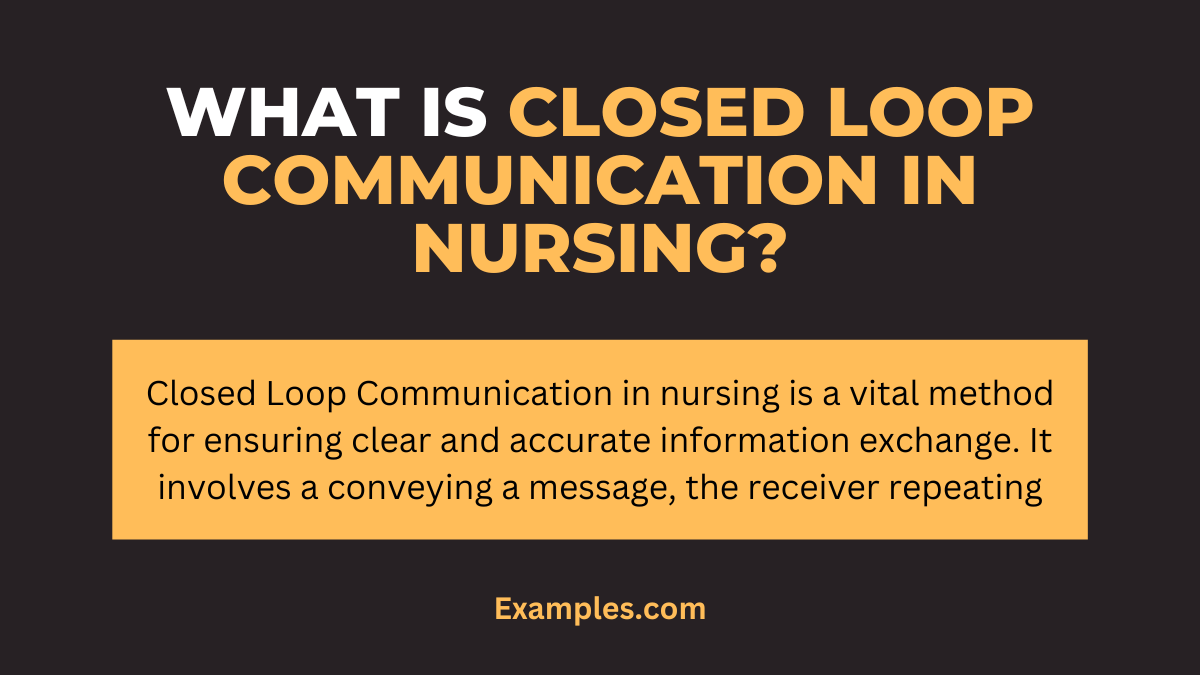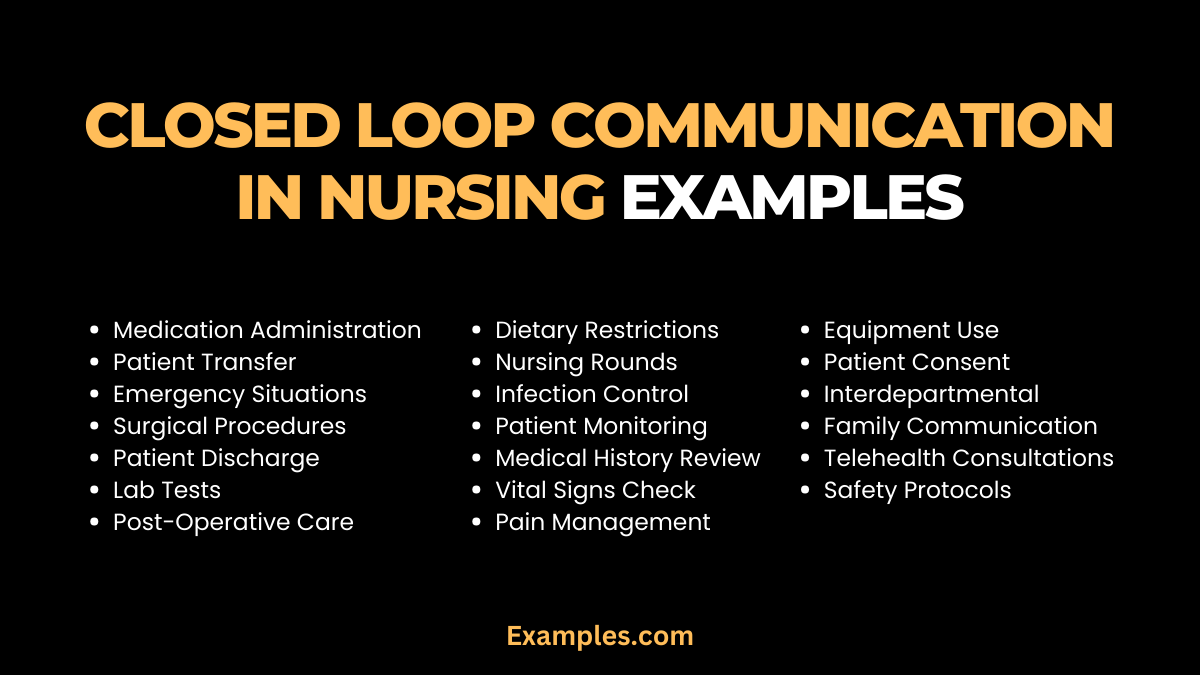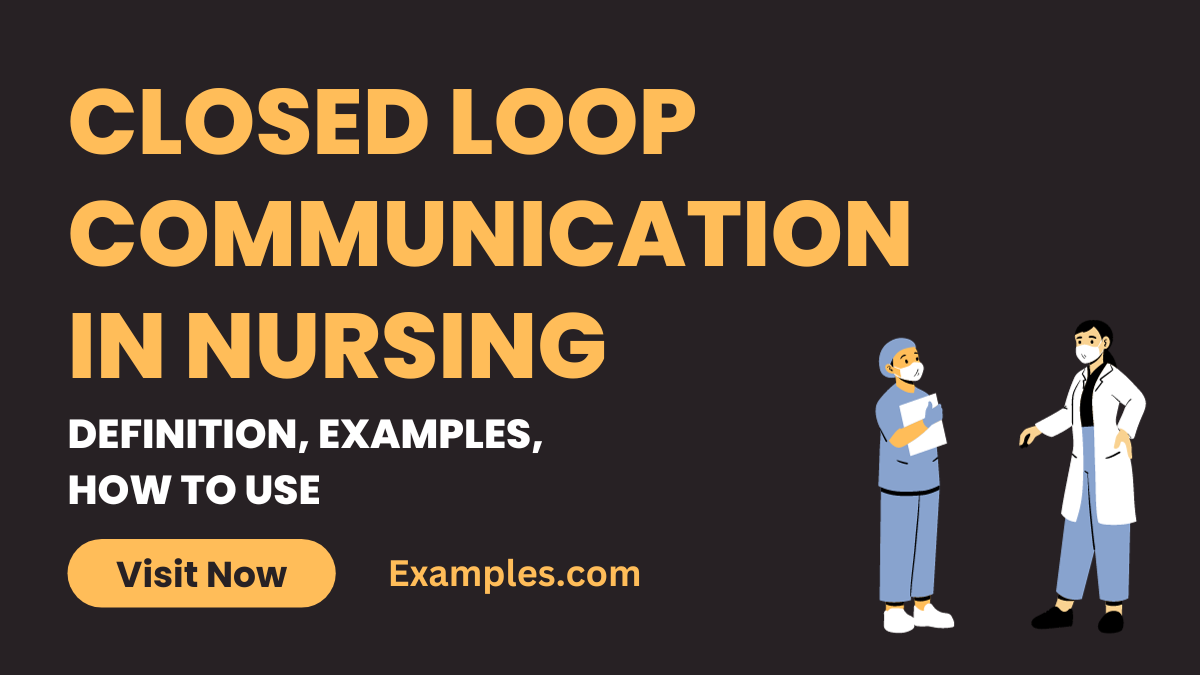19+ Closed Loop Communication in Nursing Examples
Closed Loop Communication in Nursing is a pivotal tool ensuring clarity and safety in healthcare environments. This guide delves into how this communication technique enhances nurse-patient interactions and teamwork within medical settings. By incorporating real-life communication examples, we illustrate the significant role of Closed Loop Communication in preventing errors, reinforcing patient safety protocols, and fostering effective collaboration among healthcare professionals. Essential for nurses, this comprehensive guide offers insights and practical applications to elevate the standard of care and improve patient outcomes in the dynamic and demanding field of nursing.
What is Closed Loop Communication in Nursing? – Meaning

Closed Loop Communication in nursing is a vital method for ensuring clear and accurate information exchange. It involves a sender conveying a message, the receiver repeating or paraphrasing it back, and the sender confirming the accuracy. This approach, an essential action for Closed Loop Communication, minimizes misunderstandings and enhances patient safety. These examples demonstrate the Closed Loop Communication in healthcare. By employing this technique, nurses can verify that instructions or patient-related information are correctly understood and executed, reinforcing effective communication and care in nursing practices.
Download Closed Loop Communication in Nursing in PDF
20 Closed Loop Communication in Nursing Examples

Closed Loop Communication in nursing is a crucial process, where clarity in exchanging information can mean the difference between effective patient care and medical errors. Here are 20 examples that illustrate the importance of Closed Loop Communication steps and its implementation in nursing:
- Medication Administration: A nurse reads back a doctor’s prescription to ensure correct medication dosage.
- Patient Transfer: Confirming patient details during handovers between shifts.
- Emergency Situations: Verifying a patient’s allergy information in an emergency.
- Surgical Procedures: Repeating back surgical instructions to confirm understanding.
- Patient Discharge: Clarifying discharge instructions with a patient and their family.
- Lab Tests: Repeating a lab test order to a colleague for accuracy.
- Post-Operative Care: Confirming post-operative care steps with a surgeon.
- Dietary Restrictions: Verifying a patient’s dietary restrictions and communicating them to the dietary team.
- Nursing Rounds: Summarizing a patient’s overnight changes to the incoming nurse.
- Infection Control: Ensuring clear understanding of infection control protocols among staff.
- Patient Monitoring: Confirming understanding of patient monitoring requirements.
- Medical History Review: Double-checking a patient’s medical history with them or their family.
- Vital Signs Check: Repeating recorded vital signs to another healthcare professional.
- Pain Management: Clarifying a patient’s pain management plan.
- Equipment Use: Confirming the correct operation of medical equipment with colleagues.
- Patient Consent: Ensuring a patient understands and agrees to a procedure.
- Interdepartmental Communication: Sharing patient care information between departments.
- Family Communication: Reiterating a patient’s condition and care plan to family members.
- Telehealth Consultations: Verifying patient information and symptoms over a call.
- Safety Protocols: Confirming understanding of hospital safety protocols during emergencies.
Why is Closed Loop Communication Important in Nursing?
Closed Loop Communication is crucial in nursing for several reasons. Primarily, it ensures patient safety by minimizing the risks of miscommunication in patient care. This method involves clear message transmission, acknowledgement, and confirmation, ensuring that instructions and patient information are accurately understood and acted upon. Implementing Closed Feedback Loop Communication and Closed Loop Communication for Patients and Nurses fosters a culture of clarity and precision, which is essential in high-stakes medical environments. By reducing errors and misunderstandings, Importance of Closed Loop Communication enhances the overall quality of nursing care.
What are the Types of Closed Loop Communication in Nursing?
Closed Loop Communication in nursing can take various forms, each tailored to specific situations and needs:
- Verbal Communication: In healthcare, verbal communication involves direct oral exchange of information. This ensures that the patient has understood the instructions correctly, reducing the risk of medication errors.
- Written Communication: Written communication plays a crucial role in healthcare, especially in recording patient information and care instructions. These written records serve as a reference for the healthcare team and are essential for accurate and coordinated patient care.
- Non-Verbal Cues: Non-verbal communication in healthcare involves using body language, facial expressions, and gestures to convey messages. Healthcare providers pay close attention to non-verbal cues from patients, as they can provide valuable information about the patient’s emotional state, pain level, and overall well-being.
- Electronic Communication: With the advent of technology, electronic communication has become an integral part of healthcare. Electronic health records (EHRs), messaging systems, and secure email platforms allow healthcare professionals to exchange information efficiently and securely.
- Interdisciplinary Communication: Interdisciplinary communication in healthcare refers to the exchange of information and collaboration among different healthcare providers and departments involved in a patient’s care. This type of communication ensures that all members of the healthcare team are on the same page regarding the patient’s diagnosis, treatment plan, and progress.
These types foster effective teamwork and continuity of care, making them vital components of nursing practice. Closed loop communication techniques can be applied within each of these communication methods to enhance clarity and reduce the risk of errors in patient care.
How to Use Closed Loop Communication in Nursing?
Implementing Closed Loop Communication in nursing enhances patient safety and care quality. Start by clearly articulating medical instructions or information. The receiving nurse should acknowledge by repeating or paraphrasing, ensuring understanding. Clarify any ambiguities immediately. Confirm the communication to ensure the message was received as intended. In Closed Loop Communication in Medical, this process is vital for preventing errors and ensuring effective patient care. Regular practice and training in this method are essential.
Closed Loop Communication in nursing is a vital process for ensuring accurate and effective communication in medical settings. It involves:
- Clear Message Initiation: In nursing, effective communication begins with clear message initiation. Nurses provide instructions or information in a concise manner, ensuring it is easily understood by colleagues or patients. This initial clarity sets the foundation for accurate communication.
- Receiver Acknowledgement: Once the message is delivered, the receiver plays a crucial role by acknowledging and repeating it back. This step ensures that the information has been accurately received and understood, reducing the risk of misunderstandings.
- Confirmation by Initiator: To further enhance communication accuracy, the nurse who initiated the message confirms that the repeated message is correct. This confirmation validates that the information has been properly comprehended, reinforcing its accuracy.
- Documentation: In healthcare, documentation is essential. Nurses record these communication exchanges in medical records or patient charts. This practice ensures that a clear and accurate record of all interactions is maintained, contributing to patient safety and care continuity.
This approach is particularly crucial in Closed Loop Communication in Medical scenarios, where precise communication can significantly impact patient care.
Tips and Tricks for Closed Loop Communication in Nursing
Here are the methods to enhance Closed Loop Communication in nursing:
- Practice Active Listening: Nurses should focus on understanding the complete message, paying attention to both verbal and non-verbal cues.
- Encourage Clarifications: Create an environment where it’s okay to ask questions to ensure clarity in communication.
- Regularly Train Staff: Regular training sessions are crucial for maintaining and improving Closed Loop Communication skills among healthcare professionals.
- Use Clear, Concise Language: Avoid medical jargon, especially when communicating with patients, to prevent confusion.
- Incorporate Technology: Employ medical software designed to support Closed Loop Communication, making information exchange more efficient.
- Compare Open Loop vs Closed Loop Communication: Understanding the differences helps nurses choose the most appropriate communication method in different scenarios.
- Document Communications: Keeping detailed records of all patient interactions ensures continuity and quality of care.
- Promote Team Discussions: Encourage regular team meetings to discuss and refine Closed Loop Communication practices, enhancing team cohesion and understanding.
These expanded strategies underline the importance of effective communication in nursing, contributing significantly to patient safety and the overall quality of healthcare.
What are real life examples of closed loop systems in nursing?
Real-life examples include confirming a patient’s medication dosage, reiterating surgical procedures, and verifying patient transfer details, ensuring accurate patient care.
What are closed ended questions in nursing communication?
Closed-ended questions in nursing are specific, straightforward queries requiring short, direct answers, often used to gather precise patient information quickly.
Why use closed-loop communication in nursing?
Closed-loop communication is used in nursing to enhance patient safety, reduce errors, and ensure clear understanding of medical instructions and patient care plans.
In conclusion, Closed Loop Communication in nursing is vital for ensuring patient safety and effective healthcare delivery. The examples provided highlight its role in minimizing miscommunications and errors. Emphasizing the use of feedback mechanisms, read-backs, and clear verbal confirmations, this communication strategy is essential in nursing to ensure accurate information exchange, thereby enhancing patient care quality and safety. Implementing these practices consistently can significantly improve outcomes in healthcare settings.
Statistics Highlighting the Closed Loop Communication in Nursing
The importance of Closed Loop Communication in nursing is underscored by its role in enhancing patient safety and reducing errors. This communication method involves a clear exchange of information, where messages are not only sent but also acknowledged and verified, ensuring accuracy in patient care. During the COVID-19 pandemic, healthcare communication adapted significantly, incorporating strategies like broad interdisciplinary team inclusion, continuous communication, and the expanded use of telemedicine??.
In terms of statistics, research has highlighted various aspects of Closed Loop Communication in nursing. While electronic health records and , oral communication remains a crucial element for effective and accurate exchange across providers. The integration of high-touch and high-tech approaches is needed to address complex communication challenges in healthcare??.



